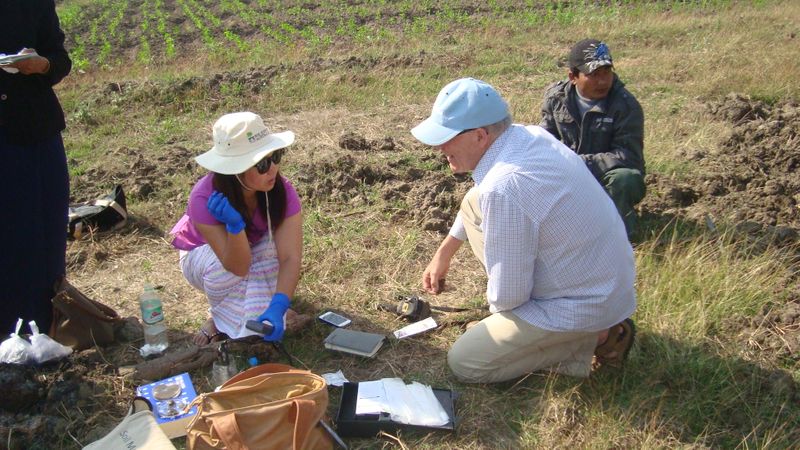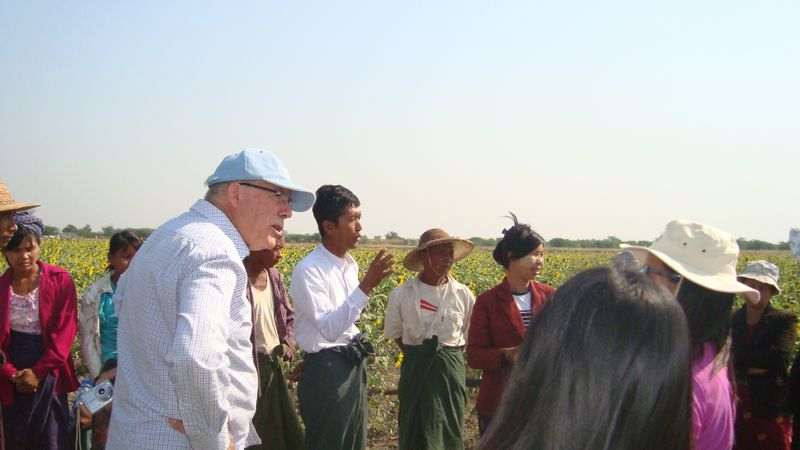Imagine yourself as a struggling farmer looking over your land knowing that your soils are too infertile to grow crops. "How can I pay my bills?" La Trobe University in Australia and Land Use Division in Myanmar ask you to join them in trialling some solutions.
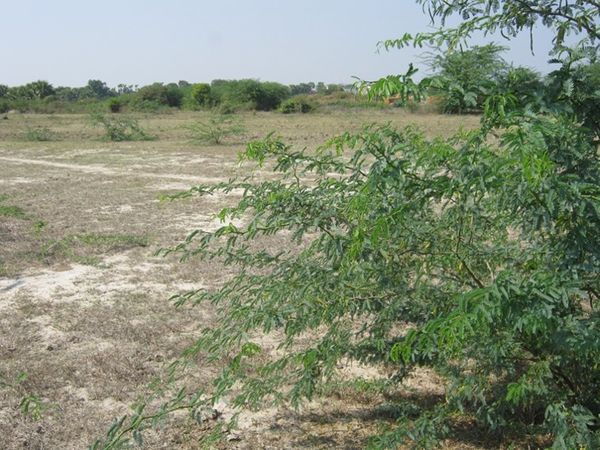
No cropping is possible on this infertile soil - but it should be!
Let's help these farming families find a way to improve their land and pay their bills. Many struggling farming families in the Central Dry Zone of Myanmar contend with heavily degraded soils, which really limits household income, for many to less than a few dollars a day. Farmers are keen to learn, try and adapt new things, but they want to have confidence things will be worthwhile, as they have few resources to risk.
This campaign is our first to raise funds for applied research on land rehabilitation in Myanmar's Central Dry Zone. This "Part 1" is to get the Ripper for trials on subsoil manuring into the Central Dry Zone region. Right now we need to buy, modify and ship a suitable Ripper to agricultural researchers on the team in Myanmar. Researchers in Myanmar have tried but are unable to find a suitable Ripper, even though they are quite common in Australia. So we have to get one organised in Geelong and ship it to Yangon via Singapore. It will be consigned to the Land Use Division in Myanmar and used for trialling deep placement of organic materials to see if there is an economic response.
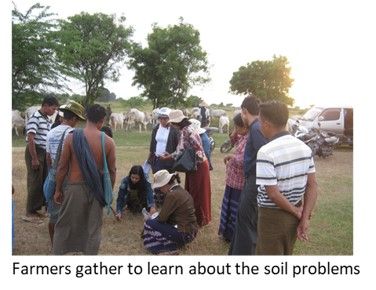
This project will conduct trials of nutrient-enriched manures in areas with good rainfall where heavily compacted soils means that no roots, and little water or nutrients are in deeper soil layers. Subsoil manuring has been developed and successfully applied in Australia in broad-acre cropping with hostile subsoils (particularly through Australia's Grains Research and Development Corporation (GRDC) supported projects with Peter Sale), and involves placing nutrient-rich organic materials at about 25-35 cm deep, from behind a single tine ripper, in rows about 1 m apart. This is done only once, with subsequent management to maintain the benefits. In Myanmar we need to: refine processing of cheap locally available organic sources (so they fall nicely behind the tine through the pipe); estimate the nutrient content of these sources and the additional nutrients required to optimize benefits, and; evaluate the profitability of the approach. The project will hopefully provide a realistic option for poor farming families to greatly improve the quality of their land to ensure their food and income security. The research is a collaboration between researchers in Australia (mostly La Trobe University) and Myanmar (mostly Land Use Division), and hopefully you.
Nang (Land Use Division, on left) and Peter (La Trobe Uni, blue hat) doing a bit of soil health assessment
Sure things are a bit crazy now with the pandemic - when things went difficult people didn’t rush to buy gold and oil, rather they went for flour, mince, pasta...ie food (....and toilet paper). Regardless, we still have to keep working on food-producing systems, even when there are distractions.
There’s a problem with these soils
The problem is that the soil is hard and compacted. The heavy monsoon rain cannot penetrate far into the soil so most of it runs off. This is a pity as the rainfall between May and November is around 750 mm which is enough for high yielding crops (a bit like Australia's Darling Downs, where average rainfall is about 600-1000 mm).
The land was farmed in the past – but the crops were so poor due to low soil nutrient and water status and compaction that they failed. The roots just could not grow down deeper into the soil. The land now grows just a little grass for cattle.
There are some 70,000 acres (about 28,000 hectares) of this wasteland soil in the Central Dry Zone. No money can be made from this land as it is. Can this land can be managed to grow good crops that will make money for the farmers?
The farmers are financially poor so that any approach to improve the land must use materials and resources available at minimal cost. Such resources (oxen manure, fertiliser, hired tractor) are available in Taungtha Township, Mandalay Region, in the Central Dry Zone. But families can only invest if they are confident of an adequate return.
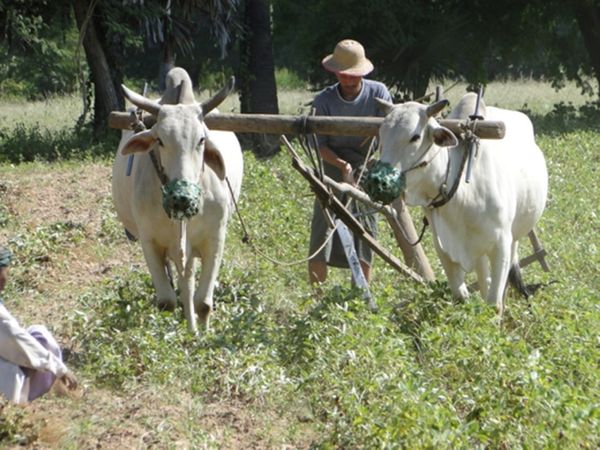
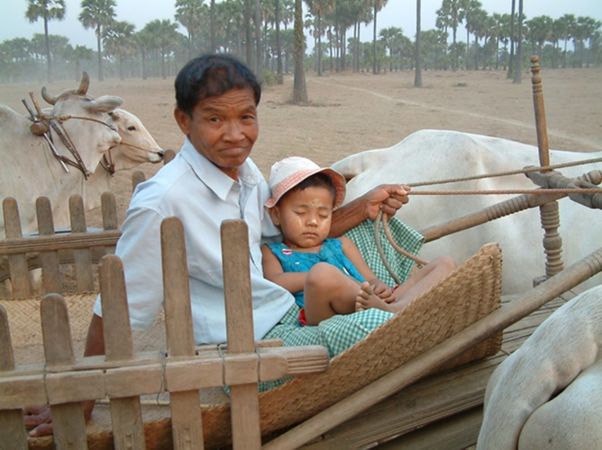
Oxen are still widely used in the Central Dry Zone, though there are tractors and contractors around for specific tasks (photos by David Herridge)
Here’s what we’re doing about it
Farmers in areas with soils suitable for this sort of amelioration are excited though skeptical, and are keen to try it. Myanmar Department of Agriculture personnel are eager to try too. Latrobe University’s Dr Peter Sale is a leader in the technique in Australia, and with Dr Thandar Nyi (Myanmar Land Use Division) and Dr Gary Clark (La Trobe Uni) will lead the implementation of the trials. Dr Robert Edis will provide some further advice about soil properties and about the conduct of research for development activities.
The plan is to set up two small pilot trials in central Myanmar, in the Wundwin and Thangtha township districts. We will work with the folk in Myanmar (farmers and agricultural officers/agronomists) to fine-tune and implement the plan outlined below.
What is planned is to refine processing of cheap locally available organic sources, then pour them from a bucket so that they fall nicely behind the tine through the attached pipe. We will estimate the nutrient content of these sources and add additional nutrients to optimize benefits. Then we will evaluate the profitability of the approach. This approach was first used in Australia in 2005.
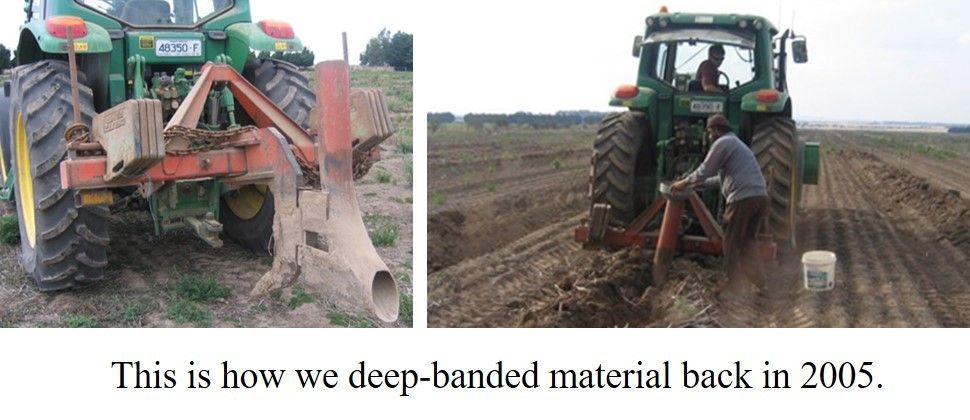
In April 2021, before the monsoon rains begin, the team will set up different treatments in plots at both sites. The best-bet treatment is probaby a high rate of oxen-manure (12 metric tonnes per hectare), containing added nitrogen and phosphorus fertiliser, placed at the bottom of rip-lines (25-35 cm deep). This will be compared with the same inputs on the surface, a half-rate of inputs in rip-lines, and with deep ripping alone.
The farmer will then sow a crop of grain sorghum (a deep rooted cereal) over the plots in mid-May and harvest the crop in late October. A second crop will be sown during the 2022 rainy season.
Will it work? Probably, but we don’t know for sure. However, we are confident in the restorative power of vigorous crop roots to improve the deeper soil layers. We do not know if a response will be big enough for farmers to adopt the practice. However, the farmers are keen to try new ideas and practices to improve their disappointing yields. But they cannot afford to try new ideas without help.
A little bit of further information (and amusement) about the Central Dry Zone can be seen in this video about the ACIAR MyPulses project that Robert Edis was involved in.

This is more like what should be happening, with abundunt crops, happy farmers, well fed livestock. This is from nearby on better soils (photo by David Herridge)
Core Crew
Dr Gary Clark, Associate Lecturer and Soil Scientist, La Trobe University, Australia
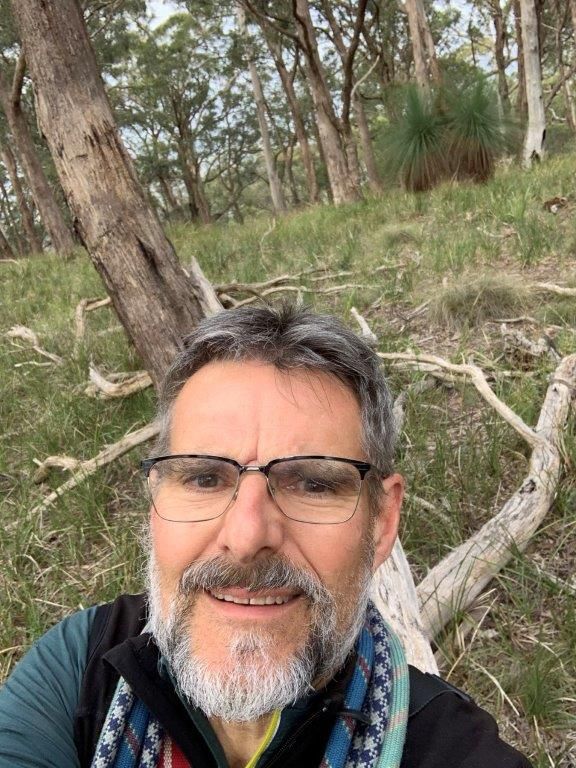
Associate Professor Peter Sale, retired lecturer and active Agronomist - La Trobe University Australia (in the blue hat)
Dr Thander Nyi, Soil Scientist (and Chair the ASEAN Regional Soil and Nutrient Management Expert Group) - Land Use Division, Myanmar, and;
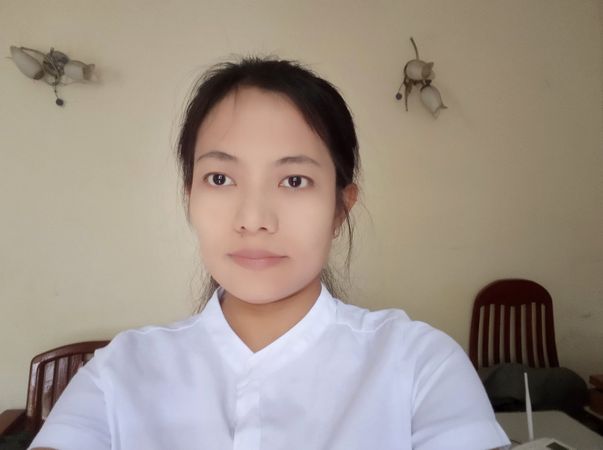
Dr Robert Edis, Soil Scientist and former Research Program Manager at the Australian Centre for International Agricultural Research for Soil and Land Management and academic at The University of Melbourne (in green hat). He is doing the editing of these pages, so complaints and comments to him! Email: [email protected]
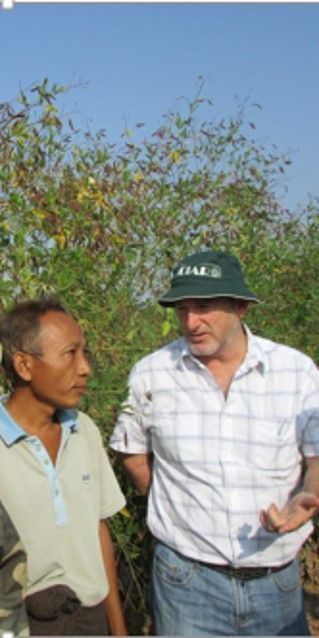
If you are new to crowd funding (like we are!)
For the full blurb you can look at the explanation by Pozible, pretty much its seeking funding participation in a project. From a crowd. A crowd of people who are interested in whats being offered, in this case to be part of a very focussed little real-world research project. You can "buy-in" as a guest, or if you think you might like to participate in other campaigns (or run your own) you can become a registered user. As a guest or registered user, once you make your pledge to this project then you will get updates etc, so you dont have to do the whole registration thing if you dont want to.
Some resources
A recent journal article demonstrating the importance of getting nutrients, organic matter and roots into the subsoil
Xiaojuan Juan Wang, Peter Sale, Helen Hayden, Caixian Tang, Gary Clark,
Roger Armstrong (2020) Plant roots and deep-banded nutrient-rich amendments influence
aggregation and dispersion in a dispersive clay subsoil. Soil Biology and Biochemistry 141 (2020) 107664
The Australian Grains Research and Development Corporation (GRDC) has sponsored several projects over the last decade or so investigating the effectiveness of subsoil manuring under different circumstances using different materials.
Subsoil manuring to ameliorate dense clay subsoils - the process, agronomic results and economics
presented also in a news article form for a quick look.
There are several articles, such as this discussion about ameliorating sodic soils, stressing the importance of being site specific for amelioration strategy and growing the right varieties as well.
Victoria's Southern Farming Systems’s information page about subsoil manuring includes reports on commercial constraints to adoption and an analysis of the business case. Southern Farming Systems is a farm driven, non-profit organisation helping higher rainfall farmers with practical research and information that produces sustainable results.
Risks - what could possibly go wrong?
Gary and Peter are unable to travel because of travel restrictions. Possible. Getting the Ripper organised in Australia will allow Peter and Gary to inspect it, to make sure it is suitable. Even if Peter and Gary are unable to go, there is confidence that it is the right equipment. Thandar and colleagues in Myanmar will be able to conduct the trials with Gary and Peter's remote help, though it is suboptimal and there may be a delay.
Equipment gets lost in transit or held up at port. Unlikely. There may be delays, but it is heavy and hard to lose or to steal. Consignment to the Land Use Division will ease passage through.
Insufficient positive response. Possible. But thats the point. The Ripper will be still there and can be used for trials elsewhere.
Exit strategy
This is a short, sharp exercise to test the technology's usefulness to reset the fertility of these soils enough to be worthwhile. What then......
If there is a response that is, or nearly is, sufficient to represent a compelling comparative value proposition - GREAT. The team has deep contacts in the rural development community in Myanmar, and they will be watching the experiments closely. Engagement with these folk will increase as the experiments progress, and there will be a workshop for next users of the findings in 2022. One option we quite like is to assist with engaging with a microfinance platform (like Kiva) to help landholders access funds to rehabilitate their soils.
If the response is not so great - let that be a lesson. We will understand the conditions under which a response might be adequate. Gear and skills aquired locally through the activity will be useful of course into the future.
Development partner-supported subsequent phase. This is a little proof of concept activity. If there is an adequate positive response there may be a strong argument for a development partner to invest more substantially to understand the limits for wider testing and scale out. This is not our focus, but we will need to keep interested parties abreast of what is going on.
Budget Overview
Right now: Purchase of heavy duty single shank ripper and tranport to region: AUD 3,500
Later: There will be campaigns looking to raise a further AUD 10,000 for travel expenses and trial implementation expenses, to assist Myanmar researchers and farmers run the trials. Peter's involvement in an ACIAR supported project in Shan State will get him into Myanmar and he can add some time in Myanmar to do work in the Central Dry Zone.
All Australian participants are providing their time for free of course, and as the project is led by La Trobe University, your contributions are tax deductible.
By the way...There are some conditions that need to apply to crowd funding projects at La Trobe University. They in fact come from the HERDC guidelines on crowd funding. The conditions are:
- Any agreement with individual contributors must be non-reciprocal in nature,
- Have no specific performance obligations, and
- Have no obligation to license, option or assign the intellectual property (or other non-financial asset) arising from the agreement back to the individual.
So, we are operating under these conditions. If you want to buy-in in a bigger way with more strings, you are welcome to make a separate arrangement with La Trobe University directly, through Gary ([email protected]) or Peter ([email protected]).
No Reward
I choose to have no reward for my pledge, and am happy just to have a tax receipt.
Tax deductible contribution
Tax deductible contribution, updates on progress and images from the field (unless you opt out).
Tax deductible contribution
Contributions over AUD $2 (without getting physical stuff) gives you tax deductible participation in agricultural research for development. You will receive photos and updates from the field, engage in dialogue if you like.
Tax deductible contribution with more serious buy-in
OK, so you are getting serious! You will get progress updates, images from the field of course, and more engagement if you like.
Lecture from Gary, Peter, Thandar or Robert
Half-hour lecture, as well as Photos/updates from the field.
